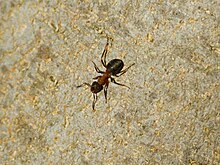Great notch ant
| Great notch ant | ||||||||||||
|---|---|---|---|---|---|---|---|---|---|---|---|---|

Great notch ant ( Formica exsecta ) |
||||||||||||
| Systematics | ||||||||||||
|
||||||||||||
| Scientific name | ||||||||||||
| Formica exsecta | ||||||||||||
| Nylander , 1846 |
The large kerb ant ( Formica exsecta ) from the subfamily of the scale ants (Formicinae) belongs to the genus of the wood ants ( Formica ) and there to the subgenus of the kerb ants ( Coptoformica ). The great insect ant was the 2011 insect of the year .
features
The guests and the back half of the head are colored brown-black to black. The mesosoma , stalk limbs and legs are mostly reddish-brown in color. The two small black spots on the pronotum and mesonotum appear indistinct and are weak to distinct. The most important distinguishing feature for Coptoformica species is the strong, central indentation of the back of the head. The workers measure 4.5 to 7.5 millimeters. The queens are 7.5 to 9.5 millimeters long and the males four to nine millimeters.
distribution and habitat
This species occurs throughout the Palearctic from Iberia and the British Isles to Eastern Siberia . It lives in Europe from the 40th to the 71st degree of latitude and occurs in the Southern Alps up to an altitude of about 2,400 meters. Preferred habitats are open or slightly shaded areas with often a high proportion of grass, such as clearings or open grasslands with individual groups of trees. Steppes that are too dry are avoided, as well as meadows that are too rich or floodplains near rivers . In all of Central Europe and Scandinavia , the great kerb ant also colonizes bog areas , where it also penetrates into the moist, central areas. The domes of the anthills are usually made of finer material than that of the red wood ant ( Formica rufa ).
Way of life
The initial colony founding is socially parasitic in the gray-black slave ant ( Formica fusca ) and Formica lemani . The colonies can become polygynous and split up when overpopulated and form branch nests. Colonies of 50 to 300 nests can develop, the largest nest domes of which can reach a diameter of up to 150 centimeters. F. exsecta is very active in building nests and has good eyesight. Insects and honeydew serve as food . F. exsecta hibernates from October to March and swarms between June and August.
swell
- ↑ Insect of the year 2011
- ↑ Dieter Otto: The red wood ants . (3rd, revised and expanded edition.), Westarp Sciences (2005); 192 pages, 77 ills., ISBN 3-89432718-9
- ↑ Bernhard Seifert : The ants of Central and Northern Europe . lutra Verlags- und Vertriebsgesellschaft, Görlitz / Tauer 2007, ISBN 978-3-936412-03-1
- ↑ Bernhard Seifert: Ants observe, determine (1st edition), Naturbuch Verlag (July 2001)

